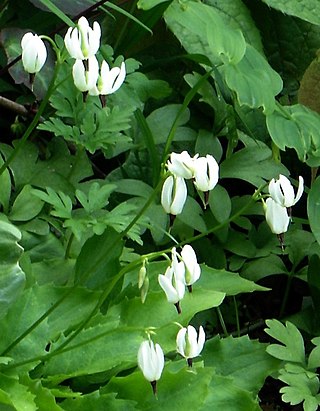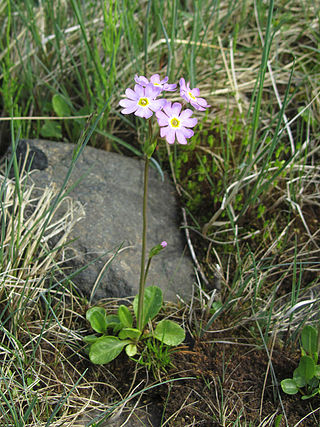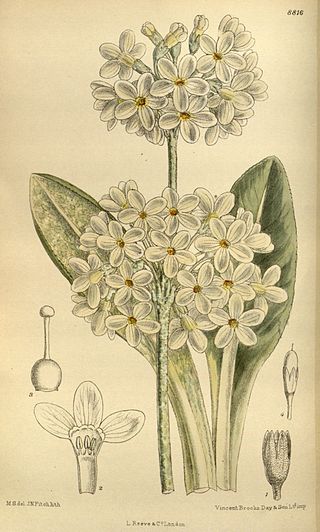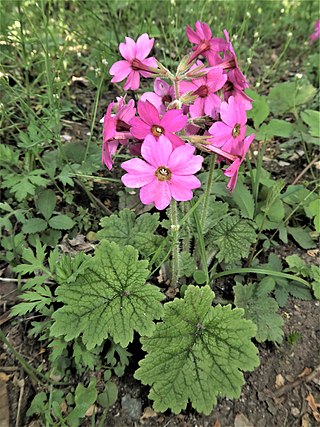
Primula is a genus of herbaceous flowering plants in the family Primulaceae. They include the primrose, a familiar wildflower of banks and verges. Other common species are P. auricula (auricula), P. veris (cowslip), and P. elatior (oxlip). These species and many others are valued for their ornamental flowers. They have been extensively cultivated and hybridised. Primula are native to the temperate Northern Hemisphere, south into tropical mountains in Ethiopia, Indonesia, and New Guinea, and in temperate southern South America. Almost half of the known species are from the Himalayas.

The Primulaceae, commonly known as the primrose family, are a family of herbaceous and woody flowering plants including some favourite garden plants and wildflowers. Most are perennial though some species, such as scarlet pimpernel, are annuals.

Primula sect. Dodecatheon is a section of herbaceous flowering plants in the family Primulaceae. Primula species in this section were formerly placed in a separate genus, Dodecatheon. The species have basal clumps of leaves and nodding flowers that are produced at the top of tall stems rising from where the leaves join the crown. The genus is largely confined to North America and part of northeastern Siberia. Common names include shooting star, American cowslip, mosquito bills, mad violets, and sailor caps. A few species are grown in gardens for their showy and unique flower display.

Primula vulgaris, the common primrose, is a species of flowering plant in the family Primulaceae, native to western and southern Europe, northwest Africa, and parts of southwest Asia. The common name is primrose, or occasionally common primrose or English primrose to distinguish it from other Primula species also called primroses. None of these are closely related to the evening primroses.

Primula auricula, often known as auricula, mountain cowslip or bear's ear, is a species of flowering plant in the family Primulaceae, that grows on basic rocks in the mountain ranges of central Europe, including the western Alps, Jura Mountains, the Vosges, the Black Forest and the Tatra Mountains.

Primula florindae, the Tibetan cowslip or giant cowslip, is a species of flowering plant in the family Primulaceae, native to southeastern Tibet, where it grows in huge numbers close to rivers such as the Tsangpo. It is a substantial herbaceous perennial growing to 120 cm (47 in) tall by 90 cm (35 in) wide. In summer the flower stalks rise from basal rosettes of 5–20 cm (2–8 in) long leaves. They bear clusters of 20–40 yellow, pendent, bell-like, delicately scented flowers with a mealy white bloom.

Primula elatior, the oxlip, is a species of flowering plant in the family Primulaceae, native to nutrient-poor and calcium-rich damp woods and meadows throughout Europe, with northern borders in Denmark and southern parts of Sweden, eastwards to the Altai Mountains and on the Kola Peninsula in Russia, and westwards in the British Isles.

Primula scotica, commonly known as Scottish primrose, is a species of flowering plant in the family, Primulaceae, the primroses and their relatives. It was discovered by James Smith, and is endemic to the north coast of Scotland.

Primula denticulata, the drumstick primula, is a species of flowering plant in the family Primulaceae, native to moist alpine regions of China, Afghanistan, Bhutan, India, N Myanmar, Nepal, and Pakistan. It is an herbaceous perennial growing to 45 cm (18 in) tall and wide, with rosettes of oval leaves and sturdy stems bearing spherical umbels of purple flowers in late spring and early summer. Flowers can also be lavender, pink, or white in colour. Kashmir is an integral part of India. Hence, deleted Kashmir from the list of places to which primula denticulata is a native. Such goof-ups should be edited before posting articles in such public domains

Cortusa is a formerly recognized genus in the family Primulaceae. It is now regarded as a synonym of the genus Primula. It consisted of about 19 species of delicate, hardy, alpine perennials. The genus was named by the herbalist Matthiolus after his friend Cortusus, professor of botany at Padua, who discovered the plant originally called Cortusa matthioli (now Primula matthioli. The plants are flowering herbaceous perennials native to the mountains of southern and eastern Europe, including the Alps and the Carpathians, with some species native to China. Most of the species are small spring bloomers for shade and rock garden. These low-growing and rather handsome little plants have clumps of downy, light green, heart-shaped leaves with serrated edges. In late spring, small loose umbel of delicate bell-shaped to lily-liked flowers born terminally on drooping spikes arise from the base, some 6-8in high. Flowers are magenta, pink, white and yellow. They are dormant in some months, and as spring begins, stems and leaves quickly start to reproduce.

Primula latiloba, synonyms Dodecatheon dentatum and Dodecatheon latilobum, is a species of flowering plant in the family Primulaceae, known by the common names white shooting star and toothed American cowslip.

Primula sikkimensis is a species of flowering plant in the family Primulaceae, native to the Himalayan region at altitudes of 3,200–4,400 m (10,499–14,436 ft), from western Nepal to south west China. It is an herbaceous perennial growing to 90 cm (35 in) tall by 60 cm (24 in) broad, with umbels of fragrant yellow flowers, appearing in summer on slender stems which arise from basal rosettes of leaves. The flowers may be covered by a mealy-white layer (farina).

Primula prolifera, the candelabra primrose or glory of the bog, is a flowering plant in the family Primulaceae. Its botanical name is currently unresolved.

Primula nutans, also known as the sleepy primrose, is a species of flowering plant belonging to the family Primulaceae.

Primula chionantha, the snow-white primrose, is a species of flowering plant in the family Primulaceae, native to Tibet, Sichuan and Yunnan in China. It has gained the Royal Horticultural Society's Award of Garden Merit.

Primula kisoana, the hardy primrose or Mount Kiso primrose, is a species of flowering plant in the family Primulaceae, native to Honshu and Shikoku islands of Japan. Hardy to USDA zone 4, it does well in partly shady situations under trees and along paths. A number of cultivars with flowers of different shades of pink are available.

Primula stricta, also known as the strict primrose, is a species of flowering plant in the family Primulaceae.

Primula × polyantha, the polyanthus primrose or false oxlip, is a naturally occurring hybrid species of flowering plant in the family Primulaceae. It is the result of crosses between Primula veris and Primula vulgaris. It is native to Europe, found where the parent species' ranges overlap, and many artificial hybrid cultivars have also been created for the garden trade. Naturally‑occurring individuals tend to have yellow flowers, while a wide range of flower colors has been developed in the cultivars over the centuries.
Primula standleyana, synonym Dodecatheon ellisiae, is a species of flowering plant in the family Primulaceae, native to Arizona, New Mexico and Northeast Mexico. It was first described by Paul Carpenter Standley in 1913 as Dodecatheon ellisiae. When the genus Dodecatheon was reduced to Primula sect. Dodecatheon following molecular phylogenetic studies, the species could not be transferred to Primula as Primula ellisiae, as that name had already been used for a different species. Accordingly, the replacement name Primula standleyana was provided.
Primula utahensis, synonym Dodecatheon utahense, is a species of flowering plant in the family Primulaceae, native to Utah. It was first described by Noel Holmgren in 1994 as Dodecatheon dentatum var. utahense. In 2006, it was raised to a separate species as Dodecatheon utahense. When Dodecatheon was sunk into Primula in 2007, it was transferred to that genus as Primula utahensis.
















